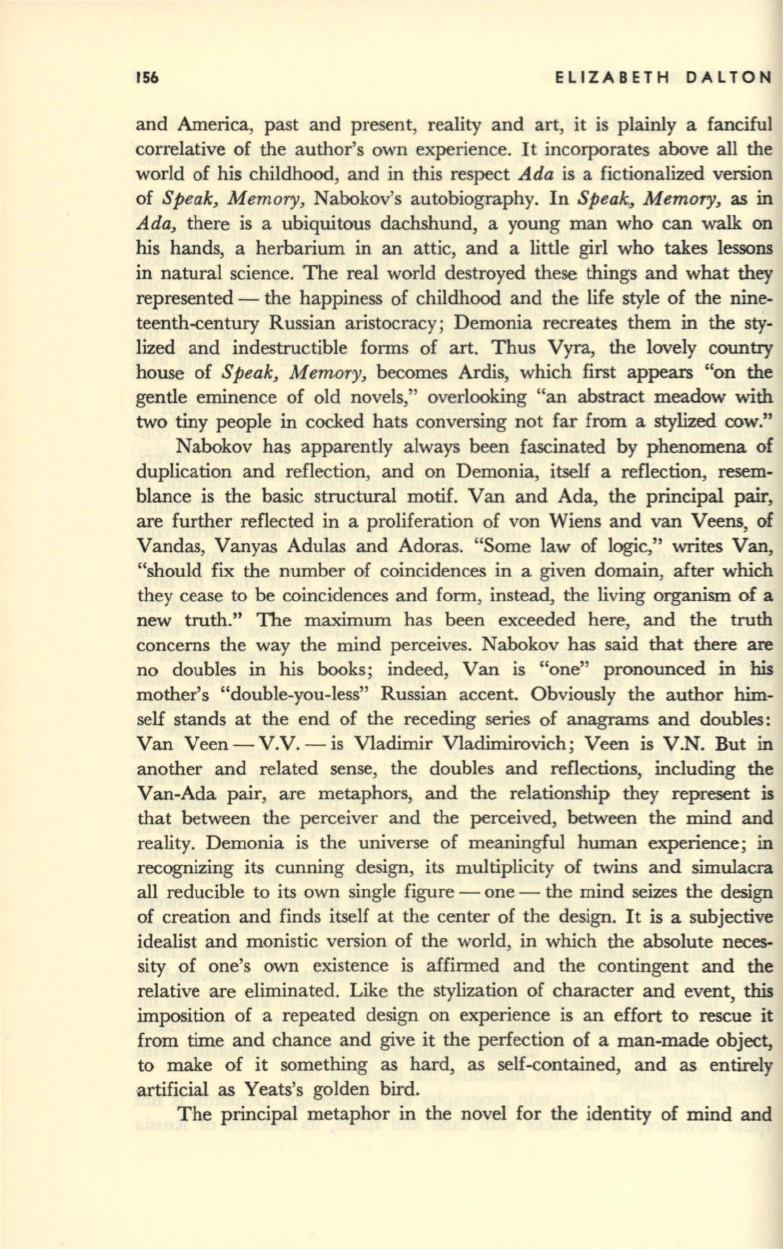
156
ELIZABETH DALTON
and America, past and present, reality and art, it is plainly a fanciful
correlative of the author's own experience.
It
incorporates above all the
world of his childhood, and in this respect
Ada
is a fictionalized version
of
Speak, Memory,
Nabokov's autobiography. In
Speak" Memory,
as
in
Ada,
there is a ubiquitous dachshund, a young man who can walk on
his hands, a herbarium in an attic, and a little girl who takes lessons
in natural science. The real world destroyed these things and what they
represented - the happiness of childhood and the life style of the nine–
teenth-century Russian aristocracy; Demonia recreates them in the sty–
lized and indestructible forms of art. Thus Vyra, the lovely country
house of
Speak, Memory,
becomes Ardis, which first appears "on the
gentle eminence of old novels," overlooking "an abstract meadow with
two tiny people in cocked hats conversing not far from a stylized cow."
Nabokov has apparently always been fascinated by phenomena of
duplication and reflection, and on Demonia, itself a reflection, resem–
blance is the basic structural motif. Van and Ada, the principal pair,
are further reflected in a proliferation of von Wiens and van Veens, of
Vandas, Vanyas Adulas and Adoras. "Some law of logic," writes Van,
"should fix the number of coincidences in a given domain, after which
they cease to be coincidences and form, instead, the living organism of a
new truth." The maximum has been exceeded here, and the truth
concerns the way the mind perceives. Nabokov has said that there are
no doubles in his books; indeed, Van is "one" pronounced
in
his
mother's "double_you_less" Russian accent. Obviously the author
him–
self stands at the end of the receding series of anagrams and doubles:
Van Veen - V.v. - is Vladimir Vladimirovich; Veen is V.N. But in
another and related sense, the doubles and reflections, including the
Van-Ada pair, are metaphors, and the relationship they represent
is
that between the perceiver and the perceived, between the mind and
reality. Demonia is the universe of meaningful human experience; in
recognizing its cunning design, its multiplicity of twins and simulacra
all reducible to its own single figure - one - the mind seizes the design
of creation and finds itself at the center of the design. It is a subjective
idealist and monistic version of the world, in which the absolute neces–
sity of one's own existence is affirmed and the contingent and the
relative are eliminated. Like the stylization of character and event, this
imposition of a repeated design on experience is an effort to rescue it
from time and chance and give it the perfection of a man-made object,
to make of it something as hard, as self-contained, and as entirely
artificial as Yeats's golden bird.
The principal metaphor in the novel for the identity of mind and


